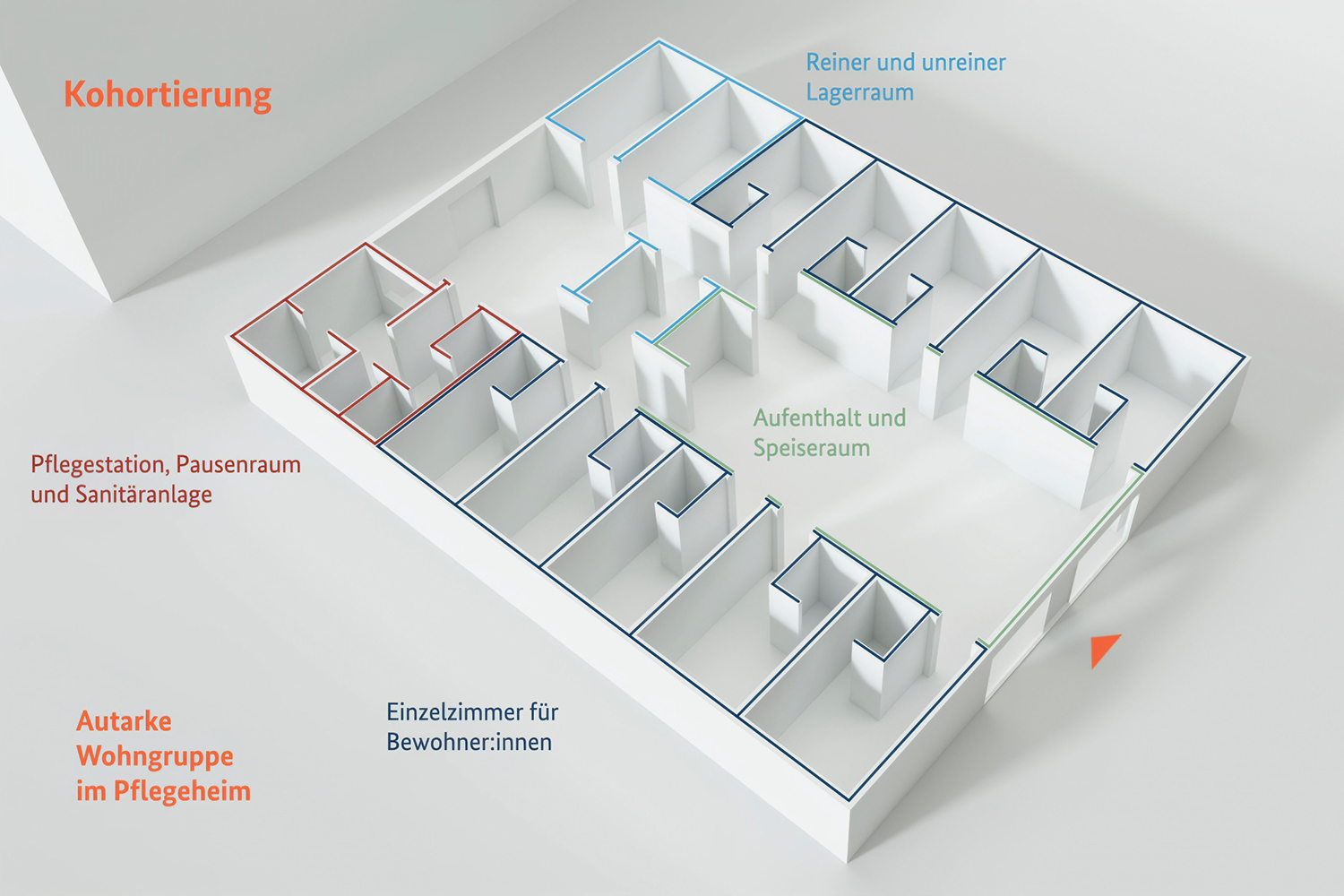The role of buildings in the spread of infections Project SAVE for the protection of critical infrastructure at the BAU 2023 trade fair
The worldwide spread of the coronavirus has made it clear: many buildings in Germany are not prepared for pandemics and the containment of infection risks. But where exactly are appropriate protective measures lacking and what can they look like? Through which structural interventions can contact transmission be avoided? These are the questions being addressed by the “SAVE” project of Technische Universität Braunschweig. The research team will be presenting its initial findings at the BAU 2023 trade fair in Munich from 17 April.

In pandemic operation, residential groups in nursing homes should be able to function independently. Photo credit: Rebecca Stumpf/ IKE
In the course of the Corona pandemic, it has become apparent that in many public facilities, constructional and technical measures urgently need to be implemented in order to reduce the risk of transmission of infectious agents in the future. This is because the role of buildings in the spread of infectious diseases has so far only been considered in a rudimentary way. In the project “SAVE – Effektive Strategien zur Kontrolle und zum Umgang mit Ausbreitungswegen von Erregern zum Schutz kritischer Infrastrukturen“ (Effective Strategies for Controlling and Dealing with Pathogen Spreading Routes to Protect Critical Infrastructures), infection prevention, constructional, technical and procedural recommendations are therefore being developed under the leadership of the Institute of Construction Design, Industrial and Health Care Building (IKE) at TU Braunschweig. The focus is primarily on propagation routes in which infections are transmitted via the air.
In particular, the researchers investigated the following questions: Which infrastructures are particularly relevant with regard to the optimisation of structural measures? Which materials are suitable for effective cleaning and disinfection? Where do most hygiene errors occur?
Interdisciplinary collaboration
Schools, day-care centres, old people’s homes and nursing homes as well as medical practices are infrastructures worth protecting and indispensable for maintaining the education system, care for the elderly and health care. However, they also represent significant sites for the development of infection. This is where the interdisciplinary research team comes in: experts from architecture, epidemiology, hygiene, material science and building services work together across disciplines. Their common goal is to recognise risk factors of infection transmission in the facilities and identify the associated processes.
To this end, the project team investigated the infection prevention options available in the various buildings. In addition to interviews with users, the researchers carried out simulations for ventilation concepts and artificially aged material samples chemically, physically and mechanically to determine how well common materials can be cleaned.
Basic hygiene and air quality control
Initial recommendations can now be derived from the results of their investigations. “In general, it is important to ensure that basic hygiene is observed across all infrastructures. These are measures that take effect in everyday life and can generally reduce the risk of infection. If there is no mechanical ventilation in heavily frequented rooms, it must be guaranteed that ventilation can take place through open windows from one side of the facade to the next, i.e. that there is a draught,” says project manager Lukas Adrian Jurk from the Institute of Construction Design, Industrial and Health Care Building (IKE) at TU Braunschweig. “Should a local outbreak situation or the next pandemic occur, structural, technical and procedural measures, such as the isolation of groups of people in independent functional units, effective airlock areas or suitable ventilation technology can contribute to infection prevention. Especially in rooms with many people who gather there over a longer period of time, the air quality should be checked regularly. Here, there should be a controlled and average CO2 concentration during the period of use of 1,000 ppm in normal operation and 800 ppm in pandemic operation. Currently, the level in many schools is up to 2000ppm and in some cases even higher.”
Knowledge platform for infection-preventive construction
Different regulations and a confusing situation in the various federal states make it difficult to both provide uniform planning recommendations and ensure simple implementation for planners. In order to facilitate access to the required information in the future, the results from the SAVE project will be bundled, visually prepared and published in an easily understandable way on the “Database of Architecture and Health Environment” from 2024. The focus will be on floor plan typologies, building services, equipment and structural details, right through to process planning. In previous research projects of the research partners involved in the SAVE project, other infrastructures such as the intensive care unit or emergency room were examined more closely. The results of these projects will also be published in the database.
The knowledge platform is intended to contribute to rapid and targeted action and infection prevention, as there is currently a lack of scientific evidence on structural infection prevention, especially for schools, day-care centres, old people’s and nursing homes and medical practices.
